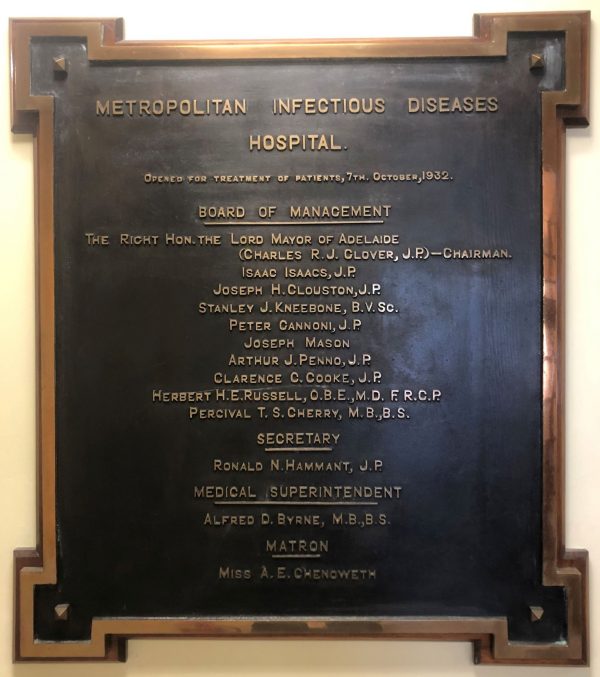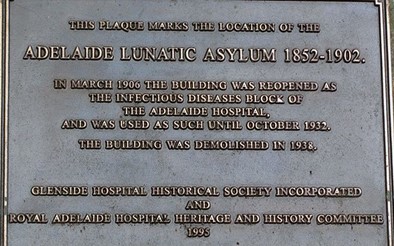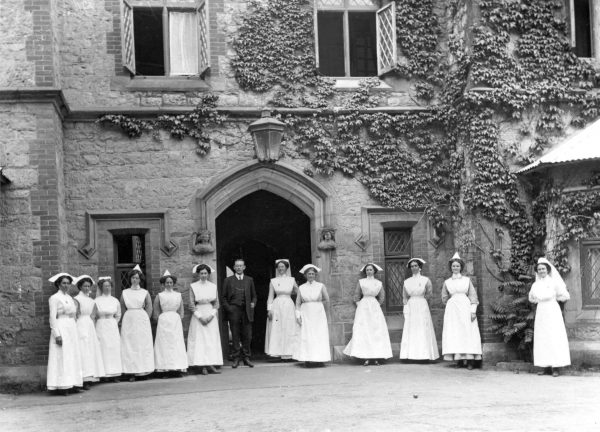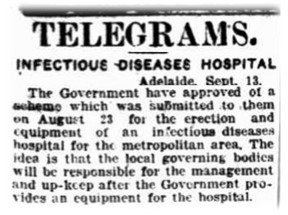
The SA Health Museum, situated in what was originally the Administrative Building of the Metropolitan Infectious Diseases Hospital, houses two large brass plaques in the entrance to the building: one lists the members of the Hospital Board when it was established in 1932, and the second, when the hospital campus was transferred to the Royal Adelaide Hospital in 1948. These plaques prompted the beginnings of an extensive research project to investigate the Board Members, and to discover their stories. The research was conducted by SA Health Museum volunteer, Karyn Baker (Board Member Biographies were completed in 2023).
1800’s – Infectious Diseases in the early days
There were grave concerns raised by the community over the frequent outbreaks of infectious diseases in South Australia, and the lack of suitable accommodation available in the Adelaide Hospital, throughout the 1800’s and into the next century. (Diseases common at the time include diphtheria, whooping cough, smallpox, tuberculosis, influenza, measles, chicken pox, syphilis and scarlet fever). At that time, infectious diseases were usually isolated at home, however, out of necessity many were admitted to the Adelaide Hospital, in spite of inadequate facilities for the isolation of infectious patients and the risk of cross infection.
On the 1st September 1899, the Herald Newspaper published an article regarding these concerns, with one clear message:
What we need is a general infectious diseases hospital,
and the sooner we get it, the better.
1906 – Lunatic Asylum converted to Infectious Diseases Ward

The Government’s response to better manage infectious disease outbreaks was to transfer the Adelaide Lunatic Asylum to the Adelaide Hospital, and re-purpose it as an Infectious Diseases Ward. Opening in March 1906, it was used for this purpose until October 1932.
The memorial plaque (photo on right, taken in the Adelaide Botanic Gardens) marks the site of the Adelaide Lunatic Asylum (demolished in 1938).
The Adelaide Lunatic Asylum was open from 1852 until 1902 (when all patients were moved to the Parkside Lunatic Asylum), and in March 1906, ownership of the Asylum building was transferred to the Adelaide Hospital.

1917 – Purchase of Land on Hampstead Road
The land on which the Metropolitan Infectious Diseases Hospital was built was owned by Leopold Conrad, the owner of a chain of butcher shops and a wealthy man, who originally used the site for grazing stock. He sold the land to the Government in 1917, which was later selected as a suitable site for a new Infectious Diseases Hospital.
1921 – Plans for a new Infectious Diseases Hospital

The plans to build a new Infectious Diseases Hospital were approved in 1921, and agreement reached that while the Government would fund the erection and equipment for the new hospital, the local governing bodies (Boards of Health and Local Councils) would be responsible for the ongoing management and upkeep of the hospital.
The article (right) appeared in the Border Watch (Mount Gambier, SA) on Tuesday 13 September 1921.
1922 – Polio Epidemic hits South Australia
In South Australia, polio was proclaimed a notifiable disease on 23rd February 1922 in response to the first large epidemic, which struck the State in early January 1922. At that time many hospitals were unable to cope when it became necessary to isolate patients. Following this epidemic, the South Australian Parliament passed the Metropolitan Infectious Diseases Act (however, the Act was not fully implemented for another 10 years, when the new Infectious Diseases Hospital opened in 1932).
1924 – Plans for new hospital approved on Conrad’s Land site
On the 4th January 1924, an article in The Advertiser reported that “The government some time ago decided to remove the Infectious Diseases Hospital from the old and out-of-date buildings on North Terrace, and a new hospital will be built on a 40 acres lot of land known at the time as Conrad’s land. The lay-out plan has received approval, and the grounds will be divided into non-infected and infected areas….the infected area will include 19 pavilion ward blocks grouped according to the infectious disease they will be called upon to house – Scarlatina, diphtheria, measles, chicken-pox, erysipelas and whooping cough”.
The article continues, “The buildings, when erected, should present a pleasing appearance…constructed in brickwork of a simple and pleasing design…it will be some months before tenders are called for a scheme of this nature, which comprises 37 separate blocks of buildings.”
It would be another 8 years before the new Metropolitan Infectious Diseases Hospital was completed and ready to admit patients.
1929 – Selection of Infectious Diseases Hospital Management Board
An article in The Advertiser (Friday 20 December 1929) informed its readers that the Government had selected the personnel of the Infectious Diseases Hospital Board:

- The Lord Mayor of Adelaide Mr Lavington Bonython as Chairman (later replaced by the Lord Mayor current at the time the hospital opened in 1932)
- Alderman Isacc Isaacs, representing the Board of Health
- Mr Joseph Hervey Clouston (Port Adelaide)
- Mr Stanley John Kneebone (Unley)
- Dr Herbert Henry Ernest Russell & Dr Percival Thomas Spower Cherry were both appointed to represent the British Medical Association
- Mr Peter Gannoni representing the local Board of Health for the municipalities of St Peters and Kensington and Norwood, and the districts of Walkerville, Payneham and Campbelltown
- Mr Joseph Mason representing the local Board of Health for the municipalities of Hindmarsh, Thebarton and Glenelg, and the district of West Torrens
- Mr Arthur James Penno representing the local Board of Health for the municipality of Brighton, and the districts of Burnside, Mitcham and Marion
- Mr Clarence Charles Cooke representing the local Board of Health for the municipality of Henley and Grange, and the districts of Prospect, Woodville and Yatala South.
In addition to the previously mentioned Board members, the following were also selected to serve on the Board of Management when the Hospital opened in 1932:
- The Right Honourable, The Lord Mayor of Adelaide, Charles Richmond John Glover, J.P. (Chairman, in place of Mr Lavington Bonython, previously selected in 1929)
- Mr Ronald Norman Hammant (Secretary)
- Miss Ada Elizabeth Chenoweth (Matron)
- Dr Alfred Dudley Byrne (Medical Superintendent)

1932 – Metropolitan Infectious Diseases Hospital Opens for Business
The initial capacity of the new Infectious Diseases Hospital in Northfield was 150 beds, and with the erection of marquees within the hospital grounds, epidemics could be coped with. It received its first patients on 7th October 1932. Initially 50 patients were transferred from the old Infectious Diseases Block at the Adelaide Hospital and gradually further patients were transferred. The Metropolitan Infectious Diseases Hospital was a large complex – by 1936 the buildings on the grounds included the Administration building, Superintendent’s quarters, nurses’ quarters, domestics quarters, gate house, mortuary, men’s quarters, workshop, stables, garage, kitchen, store, laundry, boiler room, and 17 wards.
In the first ten years or so, the Hospital treated in the order of 1,000 patients a year. Most were admitted in the winter months when the epidemics that swept Adelaide occurred. The majority of patients were suffering from diphtheria, scarlet fever, measles, whooping cough, erysipelas (an infection of the skin), chicken pox and tonsillitis. In 1936, the Hospital found itself faced with the diphtheria epidemic and in the following year, 1937, another polio outbreak hit South Australia.
1945 – Immunisation Programs a Huge Success
By 1945, mass immunisation programs for school-age children were in place and the numbers with the disease diphtheria (and eventually scarlet fever, whooping cough, measles, etc.) started to decrease remarkably. Immunisation programs and the development of new drugs (including penicillin) created a situation where there was a much lower incidence of infectious disease, reducing the likelihood of epidemics as seen in the past, and as a result the demand for hospital beds and the need for a large infectious diseases hospital was declining.
1948 – The End of an Era: Re-purposing Hampstead Centre
On the 1st April 1948, the responsibility for running the Hospital passed from Municipal control to the Royal Adelaide Hospital, and a new Management Board was elected at that time. The hospital was proclaimed an annexe of Royal Adelaide Hospital, and later became known as the ‘Northfield Wards of the Royal Adelaide Hospital’.
For further information:
- Refer Personal Biographies for members of the 1932 Board of Management.
- Refer to “Infectious Diseases Hospital – 1948 Board of Management” for the next chapter in this story. (Coming Soon)
- “HAMPSTEAD REHABILITATION CENTRE: a campus of Royal Adelaide Hospital; A History – from then to now” RAH.8/02.224
Compiled for the SA Health Museum by volunteer, Karyn Baker (November 2023)